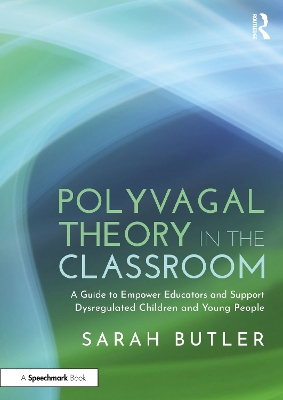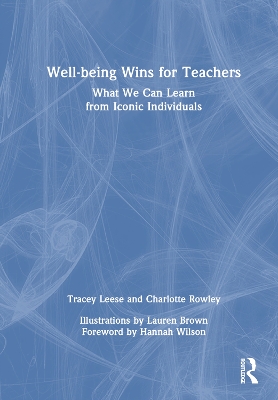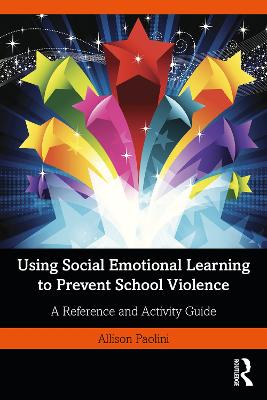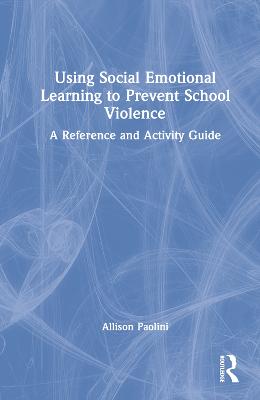Polyvagal Theory in the Classroom
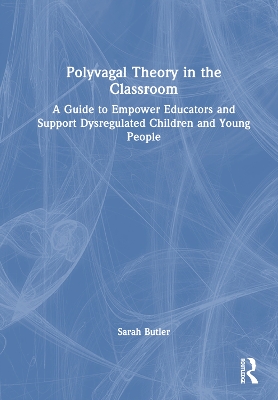 portes grátis
portes grátis
Polyvagal Theory in the Classroom
A Guide to Empower Educators and Support Dysregulated Children and Young People
Butler, Sarah
Taylor & Francis Ltd
07/2024
224
Dura
9781032500294
Pré-lançamento - envio 15 a 20 dias após a sua edição
Descrição não disponível.
Introduction
Part 1: Understanding Polyvagal Theory
Chapter 1 - What is Polyvagal Theory?
Background
The Central Nervous System
The Autonomic Nervous System
The Evolution of the Brain
The Sympathetic Nervous System
The Parasympathetic Nervous System
The Vagus Nerve
Ventral Vagal Nerve
Dorsal Vagal Nerve
The Three Autonomic States
Blended States (Dual Activation)
Signs of Threat and Signs of Safety
Emotional Regulation
Summary
Chapter 2 - Polyvagal Theory and Child Development
Piaget - Cognitive Development Theory
Erikson - Psychosocial Development Theory
Vygotsky - Sociocultural Theory
Bowlby - Attachment Theory
Other Ideas about Child Development - Klein and Winnicott
Pulling The Ideas Together
Summary
Chapter 3 - Polyvagal Theory and Childhood Trauma
Defining Trauma
Early Trauma and Brain Development
The Biased ANS
Hormones
Connection - Protection
Summary
Chapter 4 - Seeing your pupils through the Lens of Polyvagal Theory
The Meaning of Behaviour
Self-Regulation, Co-regulation and Dysregulation
Impact of the Covid-19 Pandemic
Neurodevelopmental Conditions
Tracking Autonomic States
Renaming the Autonomic States
Summary
Chapter 5 - Getting to know your Autonomic Nervous System
ANS Tracking
Body and Breath
Regulation through Rhythm
Sensory Soothing
Mindful Moments
Brain workouts and Being your Best Friend
Calming Creativity
The Power of Pets
Summary
Chapter 6 - Calming the Dysregulated Child
Be Safe: Removing the threat
Feel Safe: Tuning in to your own ANS
Connect: Body Tracking, Breathing, Moving
Summary
Chapter 7 - A Whole School Approach
The Current Climate
School as a Container
Safety Starts at the Top
The Ventral Vagal Net
Transitions
Trauma-Informed, Attachment Aware, and other Approaches
Summary
Part 2: Using Polyvagal Theory with Pupils
1. Warm-ups
2. Creating a Safe Space - Boundary Setting
3. Psychoeducation
4. Self-awareness
5. Connecting to the Body
6. Connecting to Others
7. Self-soothing
8. The Connection Diet
Summary
Final Thoughts
Glossary
References
Index
Part 1: Understanding Polyvagal Theory
Chapter 1 - What is Polyvagal Theory?
Background
The Central Nervous System
The Autonomic Nervous System
The Evolution of the Brain
The Sympathetic Nervous System
The Parasympathetic Nervous System
The Vagus Nerve
Ventral Vagal Nerve
Dorsal Vagal Nerve
The Three Autonomic States
Blended States (Dual Activation)
Signs of Threat and Signs of Safety
Emotional Regulation
Summary
Chapter 2 - Polyvagal Theory and Child Development
Piaget - Cognitive Development Theory
Erikson - Psychosocial Development Theory
Vygotsky - Sociocultural Theory
Bowlby - Attachment Theory
Other Ideas about Child Development - Klein and Winnicott
Pulling The Ideas Together
Summary
Chapter 3 - Polyvagal Theory and Childhood Trauma
Defining Trauma
Early Trauma and Brain Development
The Biased ANS
Hormones
Connection - Protection
Summary
Chapter 4 - Seeing your pupils through the Lens of Polyvagal Theory
The Meaning of Behaviour
Self-Regulation, Co-regulation and Dysregulation
Impact of the Covid-19 Pandemic
Neurodevelopmental Conditions
Tracking Autonomic States
Renaming the Autonomic States
Summary
Chapter 5 - Getting to know your Autonomic Nervous System
ANS Tracking
Body and Breath
Regulation through Rhythm
Sensory Soothing
Mindful Moments
Brain workouts and Being your Best Friend
Calming Creativity
The Power of Pets
Summary
Chapter 6 - Calming the Dysregulated Child
Be Safe: Removing the threat
Feel Safe: Tuning in to your own ANS
Connect: Body Tracking, Breathing, Moving
Summary
Chapter 7 - A Whole School Approach
The Current Climate
School as a Container
Safety Starts at the Top
The Ventral Vagal Net
Transitions
Trauma-Informed, Attachment Aware, and other Approaches
Summary
Part 2: Using Polyvagal Theory with Pupils
1. Warm-ups
2. Creating a Safe Space - Boundary Setting
3. Psychoeducation
4. Self-awareness
5. Connecting to the Body
6. Connecting to Others
7. Self-soothing
8. The Connection Diet
Summary
Final Thoughts
Glossary
References
Index
Este título pertence ao(s) assunto(s) indicados(s). Para ver outros títulos clique no assunto desejado.
empower;secondary;theory;dysregulated;;behaviour;regulated;polyvagal;child;trauma;emotional wellbeing
Introduction
Part 1: Understanding Polyvagal Theory
Chapter 1 - What is Polyvagal Theory?
Background
The Central Nervous System
The Autonomic Nervous System
The Evolution of the Brain
The Sympathetic Nervous System
The Parasympathetic Nervous System
The Vagus Nerve
Ventral Vagal Nerve
Dorsal Vagal Nerve
The Three Autonomic States
Blended States (Dual Activation)
Signs of Threat and Signs of Safety
Emotional Regulation
Summary
Chapter 2 - Polyvagal Theory and Child Development
Piaget - Cognitive Development Theory
Erikson - Psychosocial Development Theory
Vygotsky - Sociocultural Theory
Bowlby - Attachment Theory
Other Ideas about Child Development - Klein and Winnicott
Pulling The Ideas Together
Summary
Chapter 3 - Polyvagal Theory and Childhood Trauma
Defining Trauma
Early Trauma and Brain Development
The Biased ANS
Hormones
Connection - Protection
Summary
Chapter 4 - Seeing your pupils through the Lens of Polyvagal Theory
The Meaning of Behaviour
Self-Regulation, Co-regulation and Dysregulation
Impact of the Covid-19 Pandemic
Neurodevelopmental Conditions
Tracking Autonomic States
Renaming the Autonomic States
Summary
Chapter 5 - Getting to know your Autonomic Nervous System
ANS Tracking
Body and Breath
Regulation through Rhythm
Sensory Soothing
Mindful Moments
Brain workouts and Being your Best Friend
Calming Creativity
The Power of Pets
Summary
Chapter 6 - Calming the Dysregulated Child
Be Safe: Removing the threat
Feel Safe: Tuning in to your own ANS
Connect: Body Tracking, Breathing, Moving
Summary
Chapter 7 - A Whole School Approach
The Current Climate
School as a Container
Safety Starts at the Top
The Ventral Vagal Net
Transitions
Trauma-Informed, Attachment Aware, and other Approaches
Summary
Part 2: Using Polyvagal Theory with Pupils
1. Warm-ups
2. Creating a Safe Space - Boundary Setting
3. Psychoeducation
4. Self-awareness
5. Connecting to the Body
6. Connecting to Others
7. Self-soothing
8. The Connection Diet
Summary
Final Thoughts
Glossary
References
Index
Part 1: Understanding Polyvagal Theory
Chapter 1 - What is Polyvagal Theory?
Background
The Central Nervous System
The Autonomic Nervous System
The Evolution of the Brain
The Sympathetic Nervous System
The Parasympathetic Nervous System
The Vagus Nerve
Ventral Vagal Nerve
Dorsal Vagal Nerve
The Three Autonomic States
Blended States (Dual Activation)
Signs of Threat and Signs of Safety
Emotional Regulation
Summary
Chapter 2 - Polyvagal Theory and Child Development
Piaget - Cognitive Development Theory
Erikson - Psychosocial Development Theory
Vygotsky - Sociocultural Theory
Bowlby - Attachment Theory
Other Ideas about Child Development - Klein and Winnicott
Pulling The Ideas Together
Summary
Chapter 3 - Polyvagal Theory and Childhood Trauma
Defining Trauma
Early Trauma and Brain Development
The Biased ANS
Hormones
Connection - Protection
Summary
Chapter 4 - Seeing your pupils through the Lens of Polyvagal Theory
The Meaning of Behaviour
Self-Regulation, Co-regulation and Dysregulation
Impact of the Covid-19 Pandemic
Neurodevelopmental Conditions
Tracking Autonomic States
Renaming the Autonomic States
Summary
Chapter 5 - Getting to know your Autonomic Nervous System
ANS Tracking
Body and Breath
Regulation through Rhythm
Sensory Soothing
Mindful Moments
Brain workouts and Being your Best Friend
Calming Creativity
The Power of Pets
Summary
Chapter 6 - Calming the Dysregulated Child
Be Safe: Removing the threat
Feel Safe: Tuning in to your own ANS
Connect: Body Tracking, Breathing, Moving
Summary
Chapter 7 - A Whole School Approach
The Current Climate
School as a Container
Safety Starts at the Top
The Ventral Vagal Net
Transitions
Trauma-Informed, Attachment Aware, and other Approaches
Summary
Part 2: Using Polyvagal Theory with Pupils
1. Warm-ups
2. Creating a Safe Space - Boundary Setting
3. Psychoeducation
4. Self-awareness
5. Connecting to the Body
6. Connecting to Others
7. Self-soothing
8. The Connection Diet
Summary
Final Thoughts
Glossary
References
Index
Este título pertence ao(s) assunto(s) indicados(s). Para ver outros títulos clique no assunto desejado.

